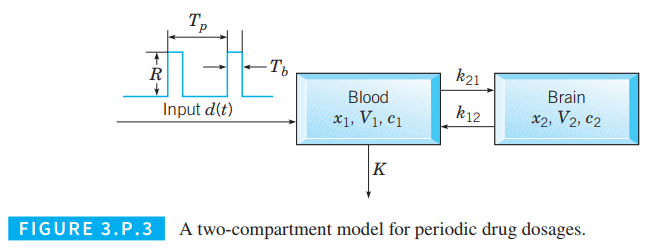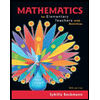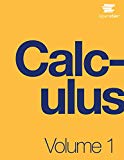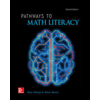
If
to show that

To prove:

and the mass balance law
Explanation of Solution
Given information:

Formula used:
Mass balance law
Proof:
Let the rate constant
Therefore, the input rate of the compartment
compartment
As
Therefore, the output rate of the drug from the compartment
compartment
By using mass balance law,
From the given figure, the input rate of the compartment
compartment
Also, the output rate of the drug from the compartment
compartment
By using mass balance law,
Therefore,
Want to see more full solutions like this?
Chapter 3 Solutions
Differential Equations: An Introduction to Modern Methods and Applications
Additional Math Textbook Solutions
A Problem Solving Approach to Mathematics for Elementary School Teachers (12th Edition)
The Heart of Mathematics: An Invitation to Effective Thinking
Calculus for Business, Economics, Life Sciences, and Social Sciences (13th Edition)
Using and Understanding Mathematics: A Quantitative Reasoning Approach (6th Edition)
Calculus Volume 2
Mathematics with Applications In the Management, Natural and Social Sciences (11th Edition)
 Discrete Mathematics and Its Applications ( 8th I...MathISBN:9781259676512Author:Kenneth H RosenPublisher:McGraw-Hill Education
Discrete Mathematics and Its Applications ( 8th I...MathISBN:9781259676512Author:Kenneth H RosenPublisher:McGraw-Hill Education Mathematics for Elementary Teachers with Activiti...MathISBN:9780134392790Author:Beckmann, SybillaPublisher:PEARSON
Mathematics for Elementary Teachers with Activiti...MathISBN:9780134392790Author:Beckmann, SybillaPublisher:PEARSON
 Thinking Mathematically (7th Edition)MathISBN:9780134683713Author:Robert F. BlitzerPublisher:PEARSON
Thinking Mathematically (7th Edition)MathISBN:9780134683713Author:Robert F. BlitzerPublisher:PEARSON Discrete Mathematics With ApplicationsMathISBN:9781337694193Author:EPP, Susanna S.Publisher:Cengage Learning,
Discrete Mathematics With ApplicationsMathISBN:9781337694193Author:EPP, Susanna S.Publisher:Cengage Learning, Pathways To Math Literacy (looseleaf)MathISBN:9781259985607Author:David Sobecki Professor, Brian A. MercerPublisher:McGraw-Hill Education
Pathways To Math Literacy (looseleaf)MathISBN:9781259985607Author:David Sobecki Professor, Brian A. MercerPublisher:McGraw-Hill Education





